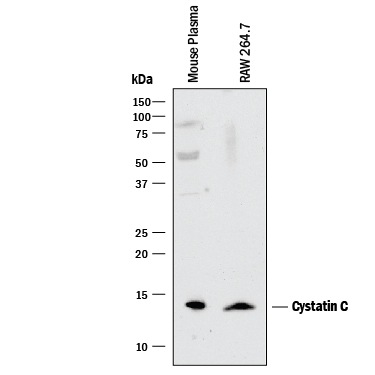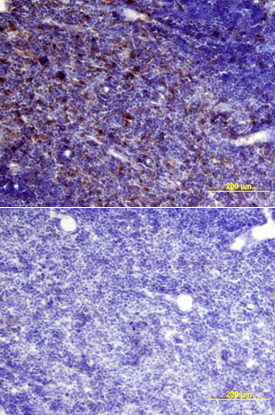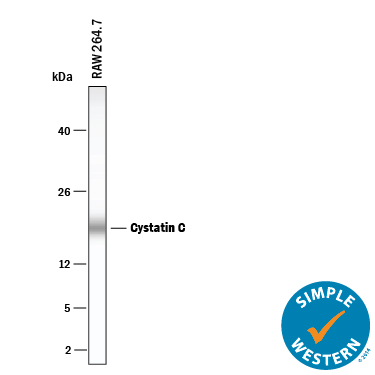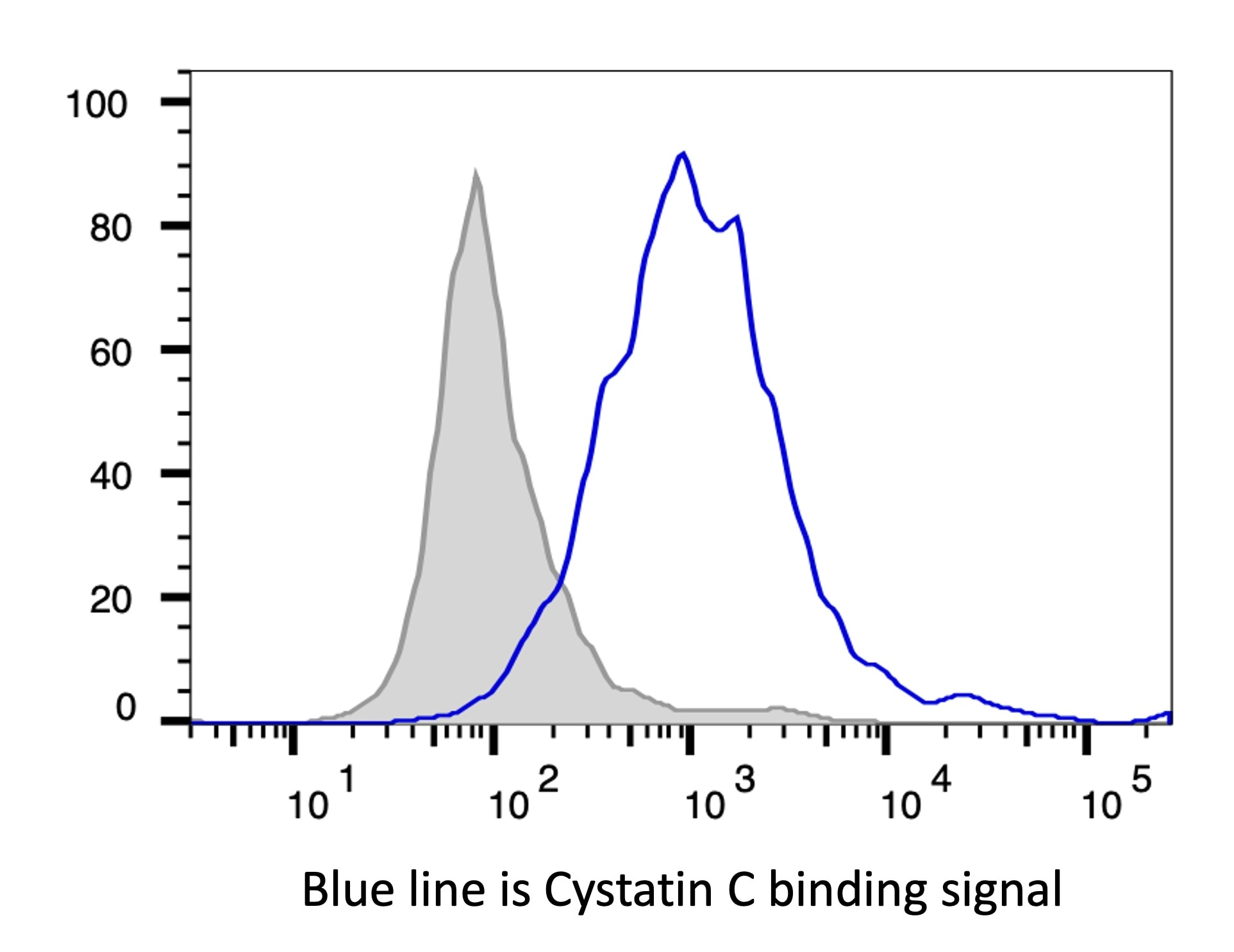Mouse Cystatin C Antibody Summary
Applications
Mouse Cystatin C Sandwich Immunoassay
Please Note: Optimal dilutions should be determined by each laboratory for each application. General Protocols are available in the Technical Information section on our website.
Scientific Data
 View Larger
View Larger
Detection of Mouse Cystatin C by Western Blot. Western blot shows lysates of mouse plasma and RAW 264.7 mouse monocyte/macrophage cell line. PVDF membrane was probed with 1 µg/mL of Goat Anti-Mouse Cystatin C Antigen Affinity-purified Polyclonal Antibody (Catalog # AF1238) followed by HRP-conjugated Anti-Goat IgG Secondary Antibody (Catalog # HAF017). A specific band was detected for Cystatin C at approximately 14 kDa (as indicated). This experiment was conducted under reducing conditions and using Immunoblot Buffer Group 1.
 View Larger
View Larger
Cystatin C in Mouse Spleen. Cystatin C was detected in immersion fixed frozen sections of mouse spleen using Mouse Cystatin C Antigen Affinity-purified Polyclonal Antibody (Catalog # AF1238) at 15 µg/mL overnight at 4 °C. Tissue was stained using the Anti-Goat HRP-DAB Cell & Tissue Staining Kit (brown; Catalog # CTS008) and counterstained with hematoxylin (blue). Lower panel shows a lack of labeling if primary antibodies are omitted and tissue is stained only with secondary antibody followed by incubation with detection reagents. View our protocol for Chromogenic IHC Staining of Frozen Tissue Sections.
 View Larger
View Larger
Detection of Mouse Cystatin C by Simple WesternTM. Simple Western lane view shows lysates of RAW 264.7 mouse monocyte/macrophage cell line, loaded at 0.2 mg/mL. A specific band was detected for Cystatin C at approximately 19 kDa (as indicated) using 10 µg/mL of Goat Anti-Mouse Cystatin C Antigen Affinity-purified Polyclonal Antibody (Catalog # AF1238). This experiment was conducted under reducing conditions and using the 12-230 kDa separation system.
Reconstitution Calculator
Preparation and Storage
- 12 months from date of receipt, -20 to -70 degreesC as supplied. 1 month, 2 to 8 degreesC under sterile conditions after reconstitution. 6 months, -20 to -70 degreesC under sterile conditions after reconstitution.
Background: Cystatin C
Cystatin C is a member of family 2 of the cystatin superfamily (1). It is involved in processes such as tumor invasion and metastasis, inflammation and some neurological diseases. It inhibits many cysteine proteases such as papain and cathepsins B, H, K, L and S (2, 3). All mouse tissues analyzed expressed Cystatin C, with relative levels similar to those of rat and human tissues. For all three species, brain and liver had the highest and lowest levels of Cystatin C, respectively, whereas kidney, spleen and muscle had the levels in between (4). The high degree of similarity in distribution and functional properties for mouse, rat and human Cystatin C indicates that a murine model should be relevant for studies of the human disease, hereditary Cystatin C amyloid angiopathy (4).
- Reed, C.H. (2000) British J. Biomed. Sci. 57:323.
- Janowski, R. et al. (2001) Nat. Struct. Biol. 8:316.
- Abrahamson, M. (1994) Methods Enzymol. 244:685.
- Hakansson, K. et al. (1996) Comp. Biochem. Physiol. 114B:303.
Product Datasheets
Citations for Mouse Cystatin C Antibody
R&D Systems personnel manually curate a database that contains references using R&D Systems products. The data collected includes not only links to publications in PubMed, but also provides information about sample types, species, and experimental conditions.
4
Citations: Showing 1 - 4
Filter your results:
Filter by:
-
Spatial and temporal heterogeneity of mouse and human microglia at single-cell resolution
Authors: T Masuda, R Sankowski, O Staszewski, C Böttcher, L Amann, C Scheiwe, S Nessler, P Kunz, G van Loo, VA Coenen, PC Reinacher, A Michel, U Sure, R Gold, J Priller, C Stadelmann, M Prinz
Nature, 2019-02-13;0(0):.
Species: Mouse
Sample Types: Whole Tissue
Applications: IHC-P -
Megalin dependent urinary cystatin C excretion in ischemic kidney injury in rats
Authors: D Jensen, C Kierulf-La, MLV Kristensen, R Nørregaard, K Weyer, R Nielsen, EI Christense, H Birn
PLoS ONE, 2017-06-02;12(6):e0178796.
Species: Mouse
Sample Types: Urine
Applications: Western Blot -
Peripheral role of cathepsin S in Th1 cell-dependent transition of nerve injury-induced acute pain to a chronic pain state.
Authors: Zhang X, Wu Z, Hayashi Y, Okada R, Nakanishi H
J Neurosci, 2014-02-19;34(8):3013-22.
Species: Mouse
Sample Types: Tissue Homogenates, Whole Tissue
Applications: IHC-Fr, Western Blot -
Urinary clusterin, cystatin C, beta2-microglobulin and total protein as markers to detect drug-induced kidney injury.
Authors: Dieterle F, Perentes E, Cordier A, Roth DR, Verdes P, Grenet O, Pantano S, Moulin P, Wahl D, Mahl A, End P, Staedtler F, Legay F, Carl K, Laurie D, Chibout SD, Vonderscher J, Maurer G
Nat. Biotechnol., 2010-05-01;28(5):463-9.
Species: Human
Sample Types: Urine
Applications: ELISA Development
FAQs
No product specific FAQs exist for this product, however you may
View all Antibody FAQsReviews for Mouse Cystatin C Antibody
Average Rating: 4 (Based on 1 Review)
Have you used Mouse Cystatin C Antibody?
Submit a review and receive an Amazon gift card.
$25/€18/£15/$25CAN/¥75 Yuan/¥2500 Yen for a review with an image
$10/€7/£6/$10 CAD/¥70 Yuan/¥1110 Yen for a review without an image
Filter by:



